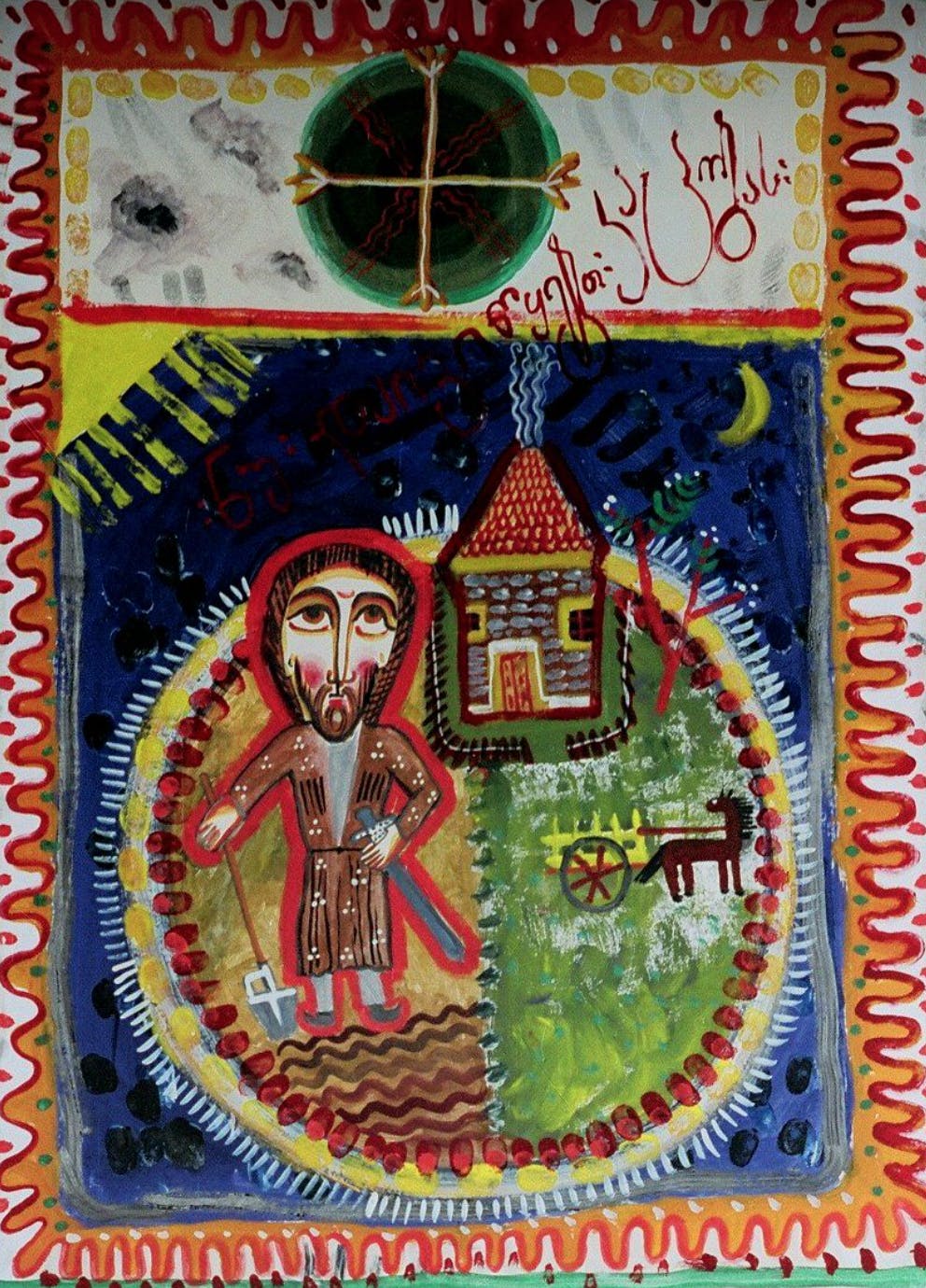Udabno
25 april–8 juni 2025

In the fall of 2024, artist Nina Kintsurashvili (Tbilisi, Georgia) undertook a residency at Konsthall C to produce a new series of paintings in response to the Sacred Spaces artistic program by Mariam Elnozahy, Artistic Director at Konsthall C. Sacred Spaces (2024-2026) is a program where artists reflect on spirituality and address questions of religion and society.
What does it mean to inherit? To inherit the weight of history? To inherit an eye? To inherit a hand? Throughout history, painting traditions have been carried on through a practice of inheritance across generations, either through the guild, through apprenticeship or, as in this case, through the family. For the first time, artist Nina Kintsurashvili is joined by her father, Lasha Kintsurashvili, in an intimate, intergenerational presentation of painting works.
Working in Georgia, in a context marred by invasion, intervention, war, and an ongoing quest for sovereignty and dignity, the artists exhibited in Udabno demonstrate a constant negotiation between rupture and repair, between recuperating lost histories and building more viable futures. An icon painter, Lasha traveled across Georgia after independence, relearning the lost art of fresco painting after the tradition was barred by the secular politics of the Soviet Union. Alongside a new generation of icon painters, Lasha worked to paint and restore Georgian Churches after years of Soviet occupation.
Here, in contrast to the grandiose fresco scale, we see intimate portraits from his native village Ruisi as well as depictions of Tbilisi in the 90s, as it was devastated by the Georgian Civil War. Though still carrying the traditional trace, here he is dedicated instead to the small gestures that mark quotidian life, experimenting with color, portraying bold characters, and expressing honest reflections of a society thrust in transition.

While Lasha’s painting practice derives from an ambition to recuperate a country decimated by decades of Soviet colonial occupation, Nina’s practice dwells in fragmentation, laying bare the scattered remains of a world fractured by the failures of the twentieth century. Formally trained in painting and mixed media, Nina’s hand is further cultivated by years of watching her father work, carefully learning and unlearning to define a practice of her own.
In hijacking the abstract, Nina is more free in form. She uses oil - a colonial medium which entered Georgia through Russia in the nineteenth century - as a sculptor would use clay or an architect would use wood - to build and rebuild. In her building-as-painting practice, perspective emerges from flatness and contrast emerges from solidity. Uncontained by the canvas, multiple images fight for one surface. As she continuously layers, forms are erased, overwritten, overruled. This is her wrestling with history.
The exhibition is defined by the tension between preservation and fragmentation - between a generation that sought to reconstruct a fractured history and one that dives headfirst into rupture. In the spaces in-between, new forms emerge, carrying the radical potential of reinvention. Like a fresco breaking along the contours of stone, the works here do not simply contain history; they are defined by it.

Nina Kintsurashvili (b.1992) lives and works in Tbilisi, Georgia. An interdisciplinary artist and painter, she earned her BFA in painting from Tbilisi State Academy of Arts in 2014 and her MFA in Sculpture & Intermedia from The University of Iowa in 2014 as a Fulbright Foreign Student. Kintsurashvili’s works have been exhibited at Gallery Artbeat, Tbilisi, Svaneti Museum of History and Ethnography, Mestia, Georgia, Public Space One, Iowa City, Iowa, Kunstraum Lakeside, Klagenfurt, Austria, LC Queisser, Tbilisi, Georgia, Ortega y Gasset Projects New York, and Tatjana Pieters, Ghent, among others.
Lasha Kintsurashvili (b.1968) is a Georgian painter, iconographer, fresco conservator and calligrapher. In 1985 he graduated from Physical Mathematical School named after V. M. Komarov. At the same time he attended an art specialized school of the Georgia Ministry of Education, in the field of Fine Arts. Lasha continued his studies in the same year at Georgian Technical University, at the architectural department in which he graduated in 1991. After the collapse of the Soviet Union in 1991 and since gaining the Georgian Independence, Lasha has been involved in reviving the Georgian school of icon painting. In the 90s a small group of icon painters including Lasha Kintsurashvili, Amiran Bakuradze, Temur Japaridze and others, started traveling around Georgia, especially in remote mountain regions such as Svaneti, copying and re-learning the lost tradition of fresco painting. In 1989-90 he participated in restoration of medieval murals in Svaneti.
